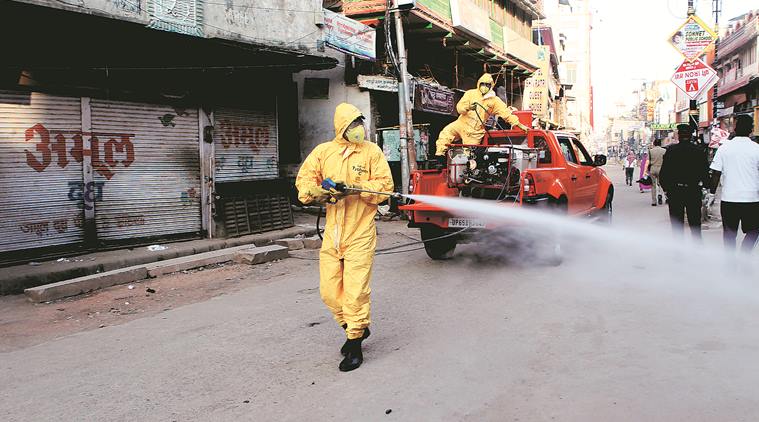 Technical committees would be formed across the districts to identify the pockets for micro containment. (Express Photo)
Technical committees would be formed across the districts to identify the pockets for micro containment. (Express Photo)
A Punjab government move to go in for micro-level containment in areas where less than 15 cases of novel coronavirus have been reported from a cluster has earned praise from Prime Minister Narendra Modi who, on Tuesday, asked all other states to adopt the model to control the spread of the pandemic to a significant extent.
The micro-level containment plan, however, is still in the works even as the authorities said that all the modalities for the same has been worked out.
“We will go in for micro containment in areas so that the infection spread could be stopped. The idea is to be more micro and pick them early rather than let cases increase to 15 or 20,” said Dr K K Talwar, Punjab government’s advisor on health issues and former director, PGI Chandigarh.
Technical committees comprising officials of district administration, respective civil surgeons, epidemiologists, experts from the government medical colleges and the World Health Organisation (WHO) would be formed across the districts to identify the pockets for micro containment.
The committees will be responsible for spot mapping, and defining the exact boundaries along with the population in the containment zone, micro-planning for house to house search for suspected Covid-19 patients as well guide data analysis of the activity.
As per the government officials, a micro containment zone is a street or two adjoining streets, a Mohalla or a residential society, either whole in case of small societies or a part of it in case of large societies, depending upon distribution of cases. In rural areas, it may be a part of village or whole village depending upon distribution of cases.
Punjab Health and Family Welfare director Dr Avneet Kaur said the micro-zones are different from containment zones as the technical committees formed at the district level will decide to cordon off smallest possible area so as not to affect large number of people in its fight to contain the spread of Covid-19.
Dr Rajesh Bhaskar, state’s nodal officer for Covid-19, added that the technical committee will factor in distribution of cases, physical continuity of the area and epidemiological link of the cases while drawing the map for such zones.
As of now 22 areas have been identified in six districts for establishing micro containment zones.
Dr Kaur said the exercise was also aimed at ensuring containment in “actionable points” instead of containment of a larger area. She said another set of committees would be formed in the districts comprising of local representatives for the implementation of guidelines in such zones.
Dr Bhaskar said as per guidelines such zones will have no entry or exit except for essential services, there will be physical barrier manned by the police and house to house screening.
Earlier in the day, during his video conference with chief ministers, Modi appreciated Punjab’s micro-containment plan and house-to-house surveillance strategy and asked all other states to adopt the model, which was helping Punjab successfully control the spread of the pandemic to a significant extent.
A state government statement said PM’s intervention came as Chief Minister Capt Amarinder Singh was describing the state’s model to combat Covid and Modi suggested that all states should follow the same strategic approach.
The house-to-house surveillance is a part of the drive being undertaken to check the community spread of the disease by engaging ASHA workers and community volunteers who go from door to door to get data about symptomatic persons and those with co-morbidities. The monitoring is being done through a mobile based app – ‘Ghar Ghar Nigrani’.
Under the programme, every person above the age of 30 will be surveyed. Persons below 30 having co-morbidity or influenza like illness or severe acute respiratory illness (SARI) would also be surveyed.
This would not be a one-time activity but an ongoing process till the containment of Covid, a government functionary said.
The survey would capture full medical conditions of a person for the previous one week and complete details of co-morbidity. This will help the state develop a database to further plan its Covid containment strategy and make targeted interventions for the community. Apart from this, the survey will also give better direction to all state Health programmes by providing ides for MIS based monitoring.
The Ghar Ghar Nigrani has been field-tested in Patiala and Mansa. Around 20,628 persons were surveyed, of whom 9,045 were found to be asymptomatic and 1,583 with symptoms of cough, fever, sore throat, or breathlessness.
The survey is currently underway in 518 villages and 47 urban wards. Around 4.88 percent persons have been found to be hypertensive, 2.23 percent diabetic, 0.14 per cent having kidney disease, 0.64 percent with heart disease, 0.13 percent having TB and 0.13 percent having Cancer. Every ASHA worker will cover 500 households. As of now, Punjab plans to test all those found symptomatic.